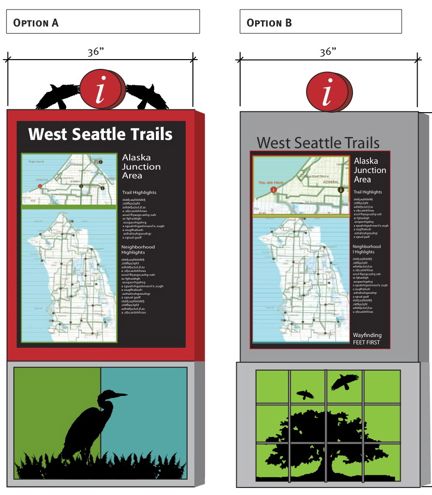
Those are two early design concepts presented to the city recently for the first 10 proposed wayfinding kiosks related to the trailblazing (in more ways than one) West Seattle Walking Trails project we first told you about 2 months ago when local activist Chas Redmond was looking for map feedback. Read on to see what kind of feedback he and the local pedestrian-advocacy group Feet First got, and to find out what happens next with this project:
The project’s already been working with the city Transportation Department and Department of Planning and Development. Then came the Design Commission taking its first look, and Redmond says, “All commissioners indicated their satisfaction with and appreciation of the serious amount of background work and community involvement this project has gone through (and continues to go through) and that they were especially appreciative of the fact that this project was a template for both other neighborhoods and for the Pedestrian Master Plan. They all said it was a great project with great community input – causing one commissioner to say ‘only in Seattle’.”
He says they did have several suggestions, including:
*make sure the map and wayfinding system address both visitors and locals
*keep the kiosks simple for maintenance and cost; Redmond says they agree in concept but there’s a potential complication with new standards set by DPD and SDOT that they have to work within
*make sure they are easy to update
*use existing street-sign poles instead of planting new ones; this too may conflict with some SDOT standards, so it’s a work in progress
*be mindful of sightline and sidewalk-right-of-way impacts; Redmond says city reps have been out to West Seattle already for an “on-location” session to work out those issues at the prototype kiosk donation at Delridge Library
WHAT’S NEXT: A variety of other steps including the $99,000 city grant application to fund some of the kiosks; map printing; city open houses for Neighborhood Matching Fund proposals such as this one; and once this proposal for 10 kiosks is successfully under way, a dozen more in other areas. Lots more information can be found on this website.

| 8 COMMENTS